There are literally thousands of jazz guitar chords, but don't worry: you don't have to learn them all to start playing jazz.
On this page we'll show you how jazz guitarists play many types of chord. We'll start simple, then hit you with some complex 'altered' shapes.
Although jazz chord charts can appear bewildering to newcomers, many complicated-looking chords are actually quite easy to play.
Many complex chords can also be substituted with simpler chords. By learning the jazz guitar chords shown below you'll be able to play any jazz song.
On this page, standard chord symbols are shown in brackets, and information about other chord symbols you might come across is provided in the text.
- Download your copy of our printable Guitar Chords eBook
- Learn more guitar chords at our main Guitar Chords Chart page
- Want to know more about the notes in each chord? Check out this page: Guitar Chord Theory
Inspiration
To get you in the mood, here is some jazz rhythm guitar inspiration (skip if you want to get straight to the chords!):
Ted Greene was a master at jazz rhythm guitar, and author of the highly-regarded Chord Chemistry (click to view at Amazon); a book which is on the bookshelf of many jazz rhythm guitarists.
First Jazz Guitar Chords
Major 7, minor 7 and dominant 7 chords appear more frequently in jazz than in rock and pop music. Even if you already know how to play these chords, make sure you can play them quickly and move between them smoothly.
Major Seventh Chords (maj7)
Jazz guitarists often play a major 7 chord even when a normal major chord is shown on the chord chart. Below are two ways jazz guitarists play a major seventh chord.
(The root note of the chord is shown with an 'R')
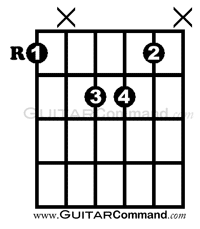
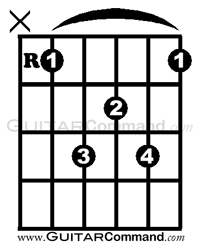
You may come across a small triangle being used as a chord symbol. This is shorthand for a major seventh chord.
Minor Seventh Guitar Chord Shapes (m7)
Minor seventh chords frequently appear in jazz music. Below are two common ways of playing minor seventh chords.
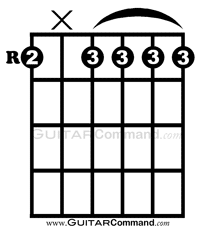
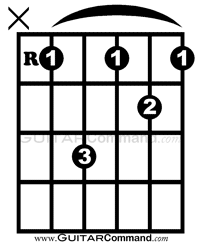
Minor 7th chords can sometimes be written as a dash followed by a 7, e.g. D-7 for a D minor seventh.
Dominant Seventh Jazz Guitar Chords (7)
Most guitarists know how to play dominant seventh chords using barre or open chords. However, jazz guitarists nearly always prefer the shapes below, as they are easy to form and can be moved around the neck quickly.

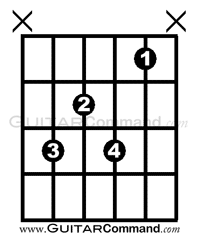
More Jazz Guitar Chords
Many jazz chords are extended versions of dominant seventh chords. This means that they contain all of the notes of the standard chord as well as additional notes that create a more interesting jazz sound.
Dominant Ninth (9) & Thirteenth (13) Chords
'Ninth' chords contain an additional ninth note.'Thirteenth' chords should, in theory, contain additional ninth, eleventh and thirteenth notes.
However, many jazz chords have so many notes that it becomes difficult, if not impossible, to play them all in one guitar chord.
In these cases, non-important notes – notes that do not affect the overall sound or purpose of the chord – can be left out. The thirteenth chord shape shown below contains only four notes.
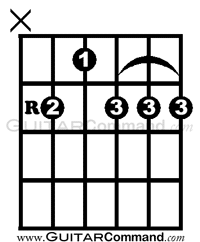

Other Useful Jazz Chords
Diminished Seventh Chords (dim7)
Diminished seventh chords often crop up in jazz chord charts. They can also be written as a small circle followed by a 7.
Diminished chords are unique in that every note they contain can be considered to be the root note.
For example, a C diminished seventh chord can also be considered to be an Eb, Gb or A diminished seventh chord.
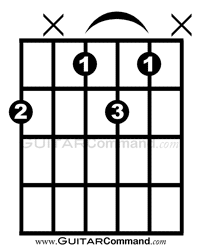
Minor Seventh Flat Fifth (m7b5)
Minor seventh flat five chords are also called half-diminished chords. Another chord symbol used to identify them is a small circle with a line drawn through it. The shape shown below is the most common way of playing these chords.
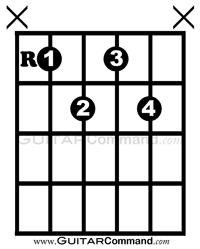
Seventh sharp five (7#5) chords are often used in the place of standard dominant seventh chords. Chords with a sharpened fifth note are also called augmented chords, and can be written with a + sign.
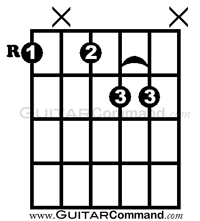
Altered Jazz Chords
Many of the most complicated-sounding jazz guitar chords are altered chords. These are simply dominant seventh chords with one or more additional notes that have either been sharpened or flattened.
For example, a G7b9 chord is a G7 chord with a flat ninth note (Ab) included in the chord.
Whenever you come across a complicated altered chord, remember that if you don't know the actual chord, you can usually replace it with the standard dominant seventh chord with the same root.
For example, if you can't remember how to play a G7#9 chord, just play a standard G7 chord.
Two common altered chords are shown below.
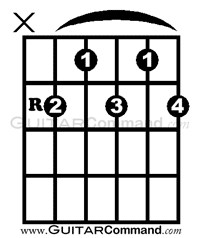
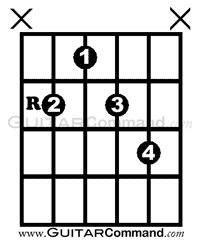
Jazz Guitar Chords Conclusion
Many beginner jazz guitarists concentrate on their lead playing, forgetting that having a good chord vocabulary is an important part of jazz guitar.
If you know several ways of playing each chord then you'll be able to play smooth, flowing rhythm guitar parts. You'll also be able to incorporate chord soloing into your lead playing.
Learning the jazz guitar chords shown above will give you a great start in jazz rhythm guitar playing.
Check out guitarists like Eddie Lang, George Van Eps and Ted Greene for jazz rhythm guitar inspiration.
- Download your copy of our printable Guitar Chords eBook.
- Learn more guitar chords at our main Guitar Chords Chart page.

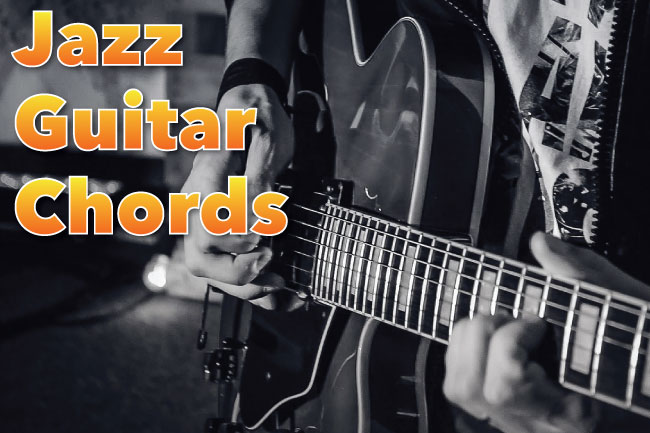

Is there a chord chart for Ted’s “Progression 4” in the video above – “A session with the Stars”?
Hi Al,
Not to our knowledge. Google might be able to throw something up for you…
Cheers,
The Guitar Command Team
Also a Bm7 b5 (B half dim)
… not really, you’d need the notes B, D, F and A for it to be a Bm7b5.
G blues cord ?
A string 8 fret F
D string 9 fret B
G string 9 fret E
B string 8 fret G
Hi David,
This is a G13 chord with the notes arranged so that there’s an F in the bass (i.e. an ‘inversion’). You could use it in blues or jazz blues.
the jass chord is really good, but place what are the number or position of the fretboard.
Thanks for the comment, Aigbe. The ‘R’ on the diagrams shows the root note of each chord shape. Find where to position movable chord shapes here: Guitar Fretboard Notes.